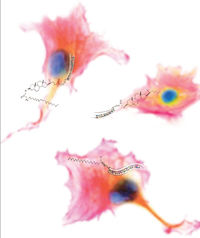Low-cost production of RNA-based vaccines and active substances
Cost-effective and flexible production systems for RNA-based active ingredients
Advertisement
Over the next three years, scientists at the Centre for biotechnology (CeBiTec) at Bielefeld University will be working on cost-effective and flexible production systems for RNA-based active substances. These substances are required for vaccines and pesticides, for example. The German Federal Ministry of Education and Research (BMBF) is supporting the project with more than 1.3 million euros. CeBiTec shares the funding with the start-up company SenseUP, which is based at Forschungszentrum Jülich.

Parliamentary State Secretary Thomas Rachel (right) handed over the funding notification to Georg Schaumann (left) from SenseUp and Prof. Dr. Jörn Kalinowski (centre) from CeBiTec.
Forschungszentrum Jülich
Ribonucleic acid, or RNA for short, is a biological substance that transmits genetic information in the body. Active substances based on RNA are currently establishing themselves as a new class of vaccines for the containment of the Corona pandemic. "For example, the vaccines from Biontech and Moderna are RNA-based agents. Here, no viral antigen is administered, only its genetic code. With this information, the immune system learns how to fight the coronavirus itself," says Professor Dr. Jörn Kalinowski. He heads the "Microbial Genomics and Biotechnology" research group at the Centre for Biotechnology (CeBiTec) at Bielefeld University.
agents with RNA can also be used for biological pest control in agriculture. "This makes them an alternative to chemical pesticides that pollute soils and groundwater and also attack beneficial insects," said Kalinowski. "RNA-based biocontrols only control fungi, weeds and insects that harm plants. This is possible because they provide a very precise code. As a result, they target individual pests while sparing related genera."
Current production of RNA expensive and demanding
Until now, RNA for vaccines and pesticides has been produced from living cells using enzymes. "Currently, the cellular components have to be elaborately prepared," says Kalinowski. "Therefore, producing large quantities of RNA-based drugs is technically challenging and expensive."
Kalinowski and his colleagues* are researching and developing new methods for the production of RNA in collaboration with the company SenseUp. SenseUP GmbH emerged five years ago from the Jülich Research Centre and specialises in modern production development. The joint project is pursuing the approach of moving the production of RNA directly into the living cell. "Bacteria are small cell factories that are designed to produce the required RNA themselves. This has the great advantage that we would only need to produce any amount of bacteria," explains CeBiTec project leader Jörn Kalinowski. "This way, we wouldn't have to rely on having all the parts for the production of RNA at our disposal and we could still produce a similarly precise RNA."
The same technology should be able to produce just a few grams for special applications as well as several tons - which would be particularly profitable for organic farming. "Insecticides need to be sprayed over a wide area," Kalinowski said. "Chemical insecticides are currently much cheaper than biopesticides. If that were to continue, organic farming would have little economic chance."
Inducing bacteria to produce a specific RNA themselves
The new method developed by the biotechnologists from Bielefeld and Jülich involves the use of safe microorganisms. Conventional methods use E. coli bacteria, which have to be purified for medical products. Safe microorganisms, on the other hand, are organisms that can be ingested through food, for example, such as baker's yeast. "For our research and development, we are using a bacterium that occurs in the soil and is already used as a production agent for animal feed," says Kalinowski. "We wouldn't have to worry about potential contamination then."
The team faces biological challenges in the project: How can a cell be induced to produce a particular RNA? "While these are natural processes, cells normally make thousands of RNAs, not preferentially one. Moreover, cells degrade RNA when they no longer need it," says Kalinowski. "Like engineers*, we have to intervene in the cells and make the bacterium make a specific RNA, even though it may not want to." The Corona pandemic has given the research field a decisive boost, he says: "We are in the early stages of our research and even if we complete the current project in three years, we will face further development work until the production system can be brought to market."
The RNAferm project started in April 2021. It is funded with more than 1.3 million euros for three years by the German Federal Ministry of Education and Research (grant number 031B1114B).
Note: This article has been translated using a computer system without human intervention. LUMITOS offers these automatic translations to present a wider range of current news. Since this article has been translated with automatic translation, it is possible that it contains errors in vocabulary, syntax or grammar. The original article in German can be found here.






















































